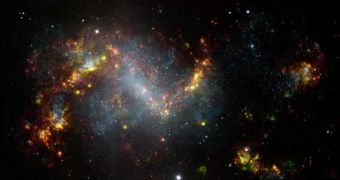Astronomers scanning the night sky were recently surprised to discover a stellar nursery that stood out from the crowd. Generally, these areas of intense stellar formation are trapped inside galaxies, where they give birth to large numbers of new, blue stars. However, there are some instances when the sheer number of new cosmic fireballs puzzles scientists, and this is definitely one of them. In the study, they discovered that the high rate at which this particular nebula was producing stars is being driven by a phenomenon that astronomers dubbed, for lack of a better term, a “superbubble,” Space reports.
The mechanisms that allow for new Suns to be born are relatively straightforward at the surface. All you need to create such an object is a large enough amount of hydrogen gas, some cosmic dust, and a lot of gravitational pull. As clouds of hydrogen begin to amass in regions that allow for this to happen – the stellar nurseries – they gradually begin exerting an increasingly stronger gravitational pull on themselves. Eventually, once they grow large enough, they reach a threshold that makes them collapse in on themselves, igniting in the process. Thus, a new star is formed.
However, the “path” is not always this simple. A lot of things can go wrong, as evidenced by the large numbers of “failed stars” out there (such as brown dwarfs). In addition, in order for cloud growth to be triggered in the first place, enough gas must exist at a particular location. This was not the case with NGC 1313, a barred spiral galaxy located some 15 million light-years away from Earth. According to astronomers, the structure shouldn't be producing new stars, but this doesn't seem to be discouraging the galaxy. Since first discovering it, experts have been hard at work in determining how it functions, and scientists using the Gemini South telescope, in Chile, finally came up with a possible explanation.
They say that a large cosmic superbubble is currently at the edge of NGC 1313, pushing gas towards the nursery, and promoting frantic stellar formation. “What triggered the superbubble is still a mystery. It would have required about a thousand supernovae to go off in the space of just a few million years, or else something punched its way through the disk and set it off like ripples in a pond,” explains Anglo-Australian Observatory Gemini scientist Stuart Ryder. He has been conducting studies on this galaxy for quite some time now.

 14 DAY TRIAL //
14 DAY TRIAL //